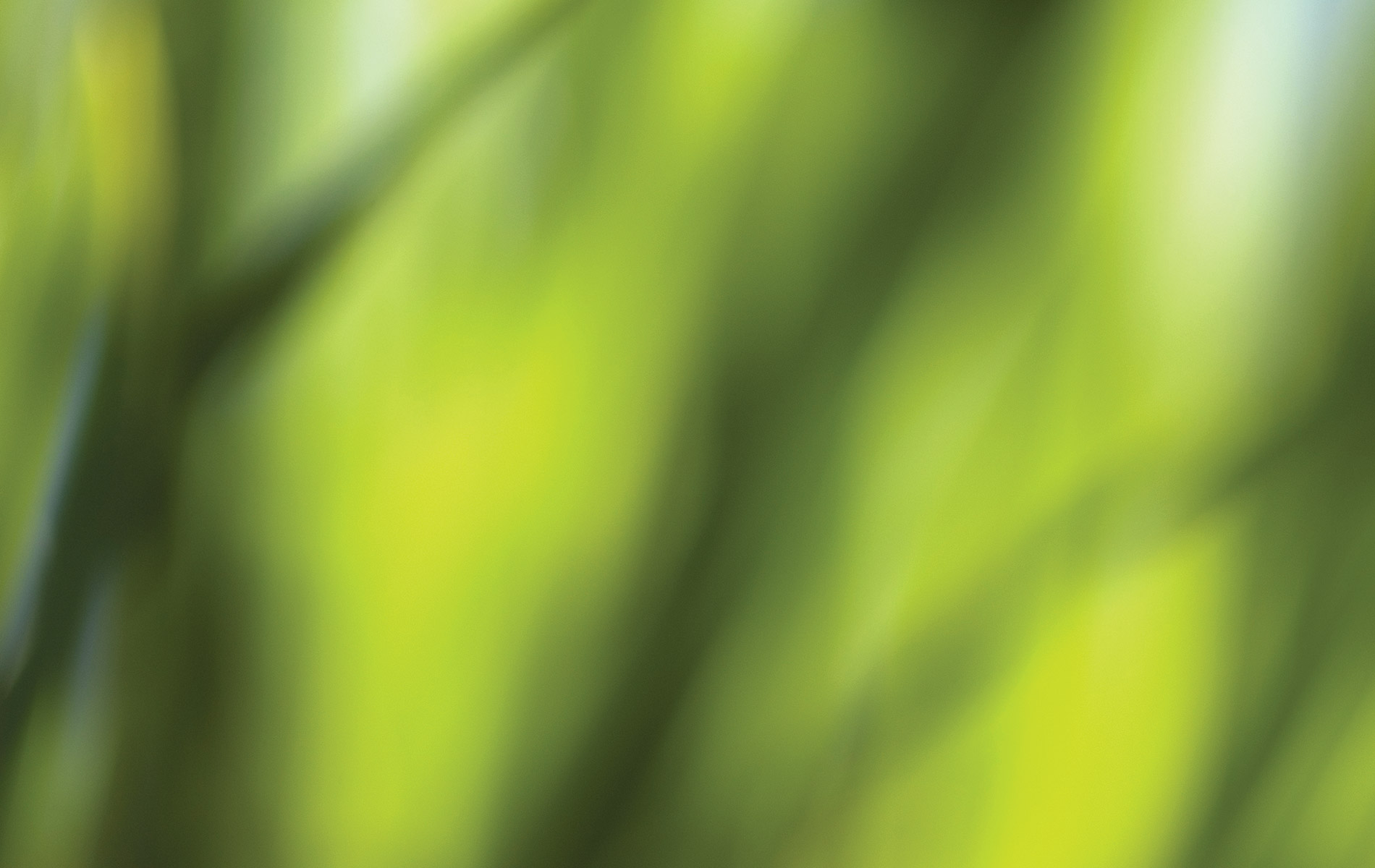
vie-magazine-grasses-in-classes
Grasses in Classes
Story and Photography by Anne W. Schultz
“… a little child will lead them.”
Isaiah 11:6
The children arrive early one June morning, exceptional in its brightness and clarity.
This magical day compares to those I experienced in the Greek islands, where the air is dry and invigorating, leaving a pure, incandescent light—a light that photographers and painters dream about, where every detail is stark and every image illuminated. Standing beneath a live oak tree, I see the children approach. High above, the crown of pine trees glows in an emerald fire, as if each bristled clump is electrified from within. This is a Florida summer day that shall be savored.
About forty fifth graders from Jill McCoy’s Bay Elementary School science class are here to plant grasses in front of our bayside home in conjunction with a school-sanctioned science program. I watch them traipse—mostly in single file—down the narrow beach, clutching plastic pots full of marsh grasses in each hand. Nimble as deer, they leap over a creek, then sidestep around craggy driftwood, weathered tree stumps, and the silvery hulk of a downed tree. Massive oak branches, swathed in Spanish moss, twist down toward them like embracing arms. With the sound of water lapping upon the shore to set the cadence, the excited children’s high-pitched voices join the chorus of the shorebirds wheeling in flight above.
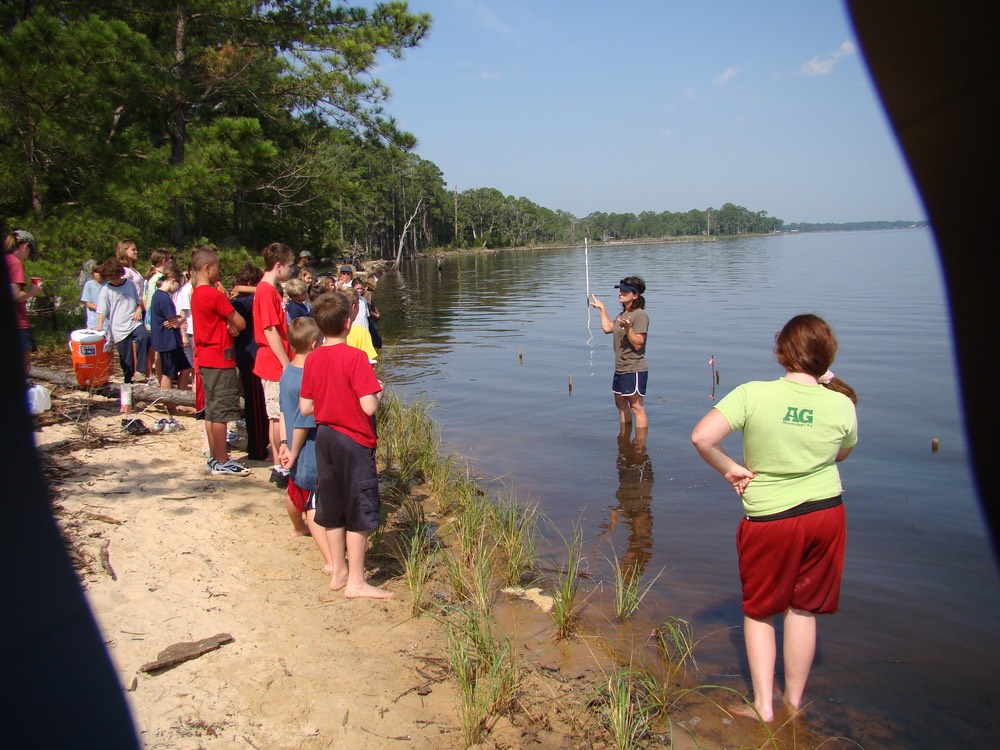
My husband and I are so grateful for their help in restoring about thirty feet of wetland that had suddenly vanished from along our bay shoreline. Looking for a more natural and less invasive alternative to a sea wall to protect the shoreline, we agreed to be part of a wetland reclamation project that implements oyster shell reefs and marsh grasses. A few weeks earlier, a large group of volunteers had spent several days constructing the oyster shell reef that would protect the plantings. Now, the children had arrived to complete the project by planting around three hundred clumps of smooth cordgrass as part of the Grasses in Classes program, sponsored by Choctawhatchee Basin Alliance (CBA) with contributions from the South Walton Community Council, a local environmental group.
Through this science program, children not only learn scientific facts about nature, but through hands-on interaction, they also intimately experience their natural surroundings. With a large percentage of families living in cities these days, I think how fortunate these children are to live within an environment that is alive, instead of one manufactured from plastic, concrete, and steel. In South Walton, children are never far from beaches, dune lakes, and state-owned forests, where they reunite with the family of nature, a larger community of life that they can connect with merely by stepping outside. Children need never feel alone when nature is their companion and friend—a life force that is as ever moving, growing, and changing as they are.
While waiting for everyone to assemble, I chat with some of the children. “I hate that not many recycle. It’s like they don’t care,” one girl shares. Another boy bubbles with enthusiasm over the gardens at Seaside School. “You should see the gardens there. They grow tons of vegetables like tomatoes, squash, eggplant, and herbs—and they’re all organic!” Another child tells me that he learned a lot about grasses, saying, “I never realized they were such a big deal.”
[double_column_left]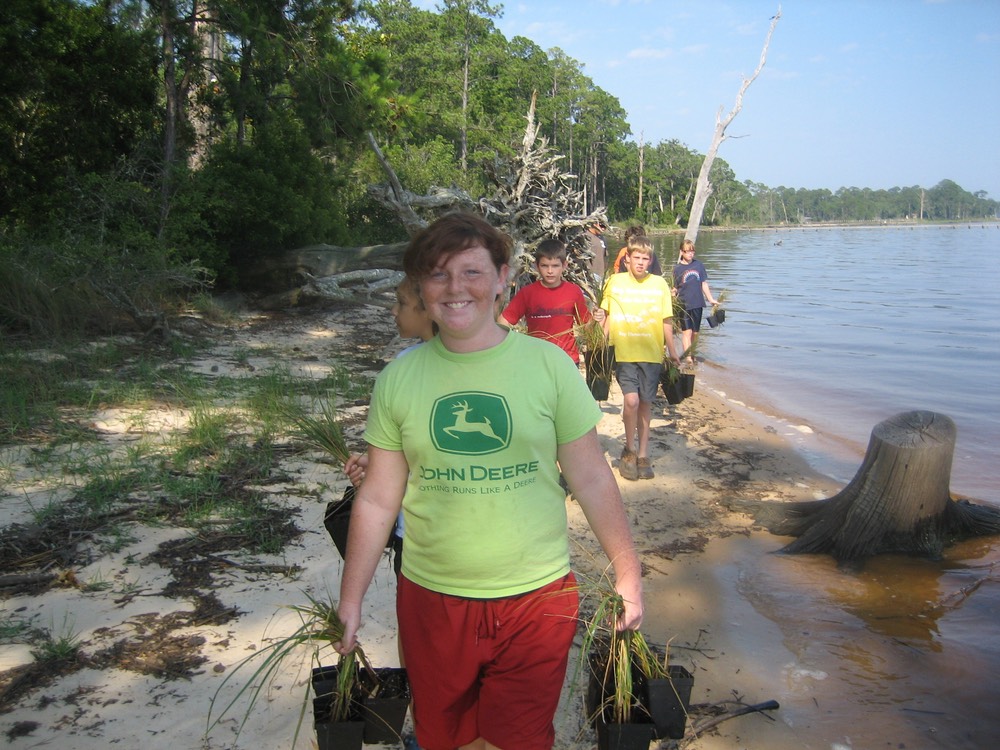
Jill McCoy and Kim Cox, the science teachers who accompany the class, tell me that the students cultivated these grass specimens from tiny shoots planted in a kiddy pool behind the school building. Each day, the children took turns tending the plants, checking water levels and sometimes adding salt if the salinity levels were too low. CBA grant manager Alison McDowell periodically visited the classroom to teach them about the many functions that grasses serve in a wetland environment, and also about watersheds.
[/double_column_right]Wearing a visor that shades her face, Alison stands ankle-deep in the bay, coaching the children in finding the ideal site for their plants. “You want to make sure the roots take hold, so keep their feet in water that’s not too deep or too shallow—about six inches is ideal,” she says. She explains that roots are important because they hold down sediment and keep the plant anchored. Soon the kids are busy shoveling holes, inserting transplants, and then patting damp sand around them. They work with a quiet efficiency and concentration that amazes me.
After finishing their task, the students stand listening with rapt attention as Alison explains how the oyster reef will expand and protect their new plantings. “Oysters float when they are babies. At the adult stage, they will attach to this oyster shell reef and over time, the reef will grow bigger and be able to soften the wave action that causes erosion.”
Then she quizzes the children on what they learned about grasses. Hands are raised and kids called on. “They make the landscape beautiful,” one girl responds. Others chime in. “They clean the water by filtering pollutants.” “They stop erosion.” “They are habitat for little crabs, shrimp, and fishes that we love to eat,” calls out another. At that point, Alison asks the children a question: “Do your dads like to fish?” “Yes,” most shout out. “These wetlands are nurseries for many fish prized by recreational fishermen as well as commercial fisheries,” Alison adds. “What happens when we have hurricanes?” A hand shoots up. “Wetlands help sponge up excess storm water,” is the answer. “Good answer, and what else?” Alison asks. “They recycle nutrients.” “Great,” she responds. “You all did a terrific job, thanks so much for coming.”
[double_column_left]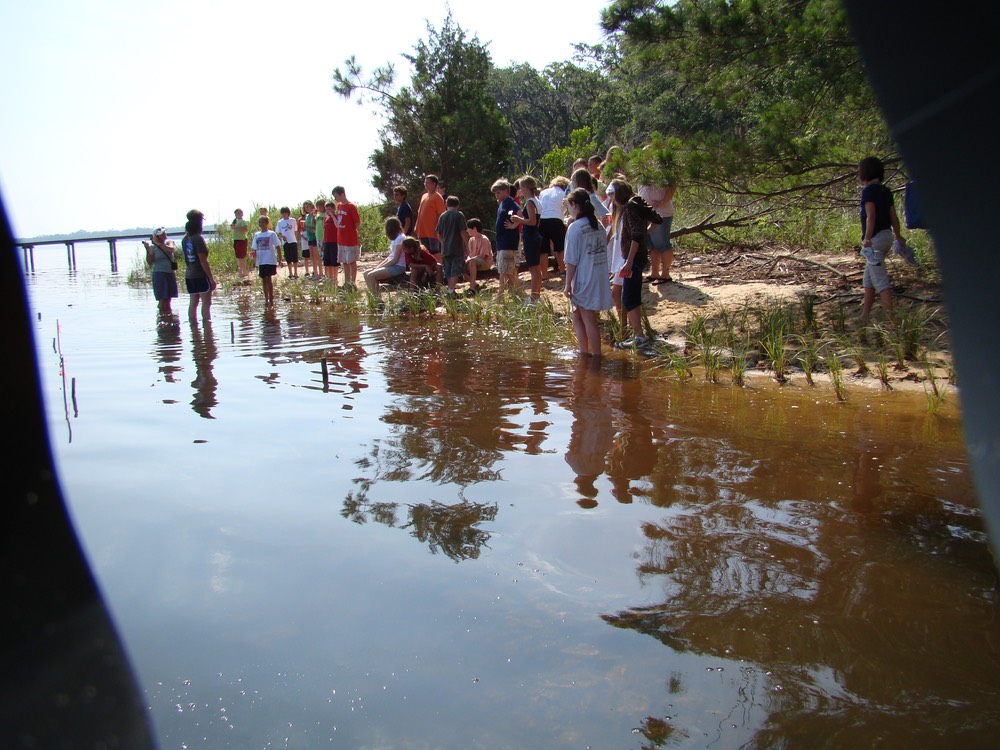
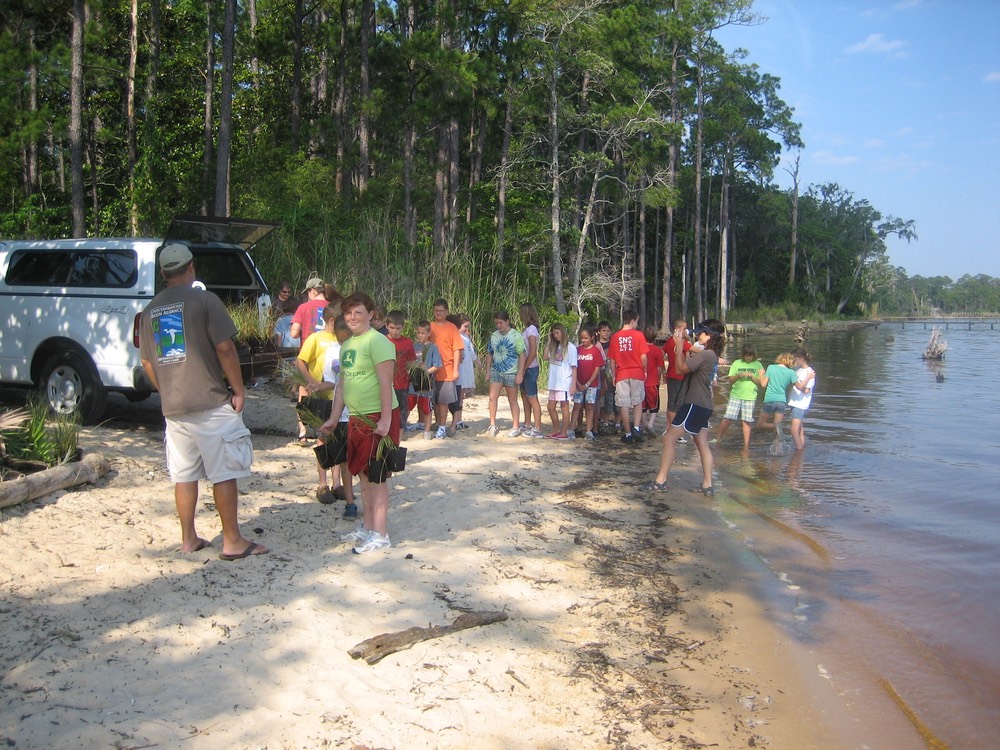
As quickly as they appeared, the class waves goodbye and retreats down the same path back to the public access where their school buses wait. The teachers invite us to visit their science class when school resumes next fall, which we look forward to. The children impressed us with their interest and enthusiasm. We are further impressed when a boy returns looking for a Band-Aid that fell from a cut on his arm. He is concerned that it might litter our property! These students realize what a beautiful place they live in and intend to make sure it stays this way. I’m sure these dedicated teachers and programs like Grasses in Classes deserve praise for inspiring and nurturing these attitudes.
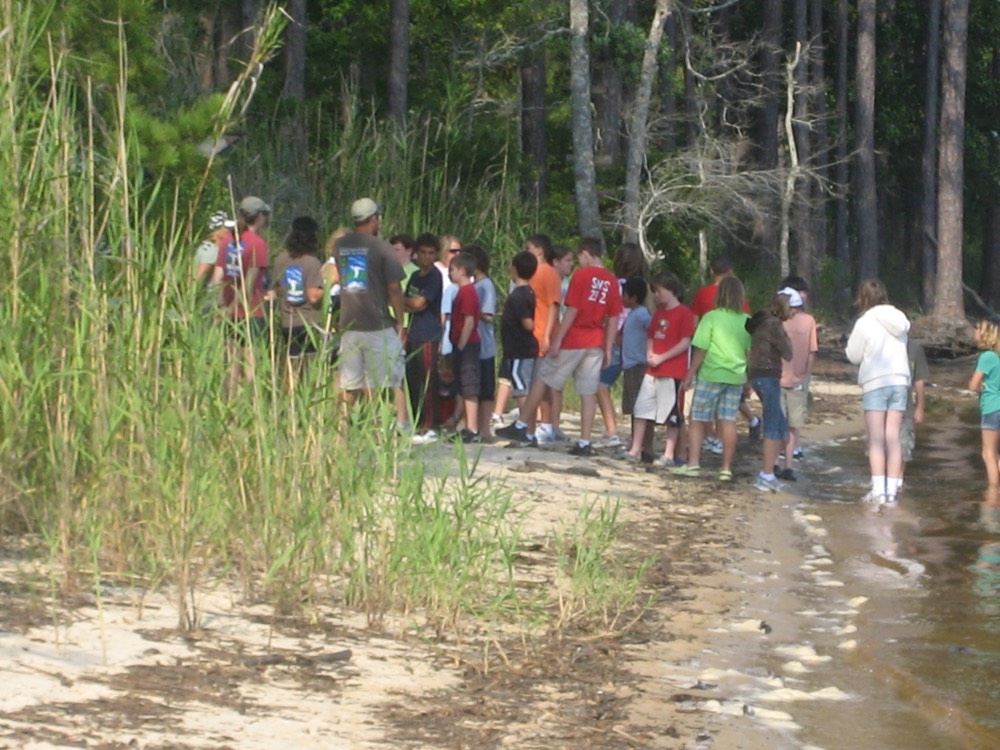
The girl I talked to earlier was right; we don’t seem to care that we are handing down to our children an earth we have abused and exploited for too long. I’d about given up hope that we would ever change the old destructive patterns like clear-cutting and filling in wetlands. Yet, these inspiring children swept into my life that morning out of nowhere, a whirlwind of fresh vitality that stirred up hope—hope not only for reclaiming our lost wetlands, but also for future preservation of the nature I hold so dear. The endearing way they talked about nature and handled it shows that they value its intrinsic qualities as well as its beneficial properties. Now, I’m confident the children will lead us down the path of stewardship as caretakers of nature. That day, I discovered it is true that a child will lead us—into a brighter future for planet Earth.
For more information on Choctawhatchee Basin Alliance and ways to help out, check out www.basinalliance.org.
— V —
Anne W. Schultz is a freelance writer living in the Point Washington forest area with her husband, Bill. The couple moved from Kansas City fourteen years ago with their adult daughter Alison, who lives nearby. A love for God’s creation keeps Anne outdoors in a kayak, walking the beach or forest trails, or traveling to unspoiled landscapes in remote locations. She and Bill are Master Naturalists in Coastal Systems certified by the University of Florida.
Share This Story!
KEEP UP WITH THE LATEST STORIES FROM VIE

































































































































